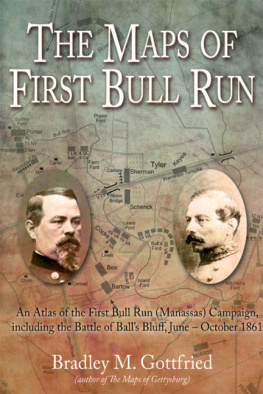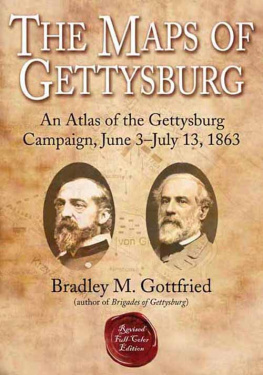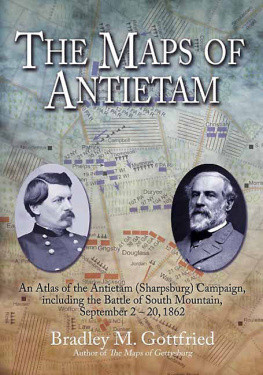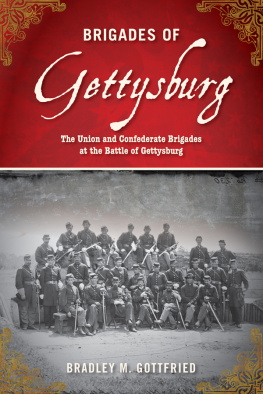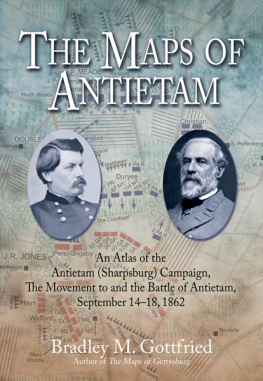

2009 by Bradley M. Gottfried
The Maps of First Bull Run: An Atlas of the First Bull Run (Manassas) Campaign, Including the Battle of Balls Bluff, JuneOctober 1861
All rights reserved. No part of this work may be reproduced, stored in a retrieval system, or transmitted, in any form or by any means, electronic, mechanical, photocopying, recording, or otherwise, without the prior written permission of the publisher. Printed in the United States of America.
Cataloging-in-Publication Data is available from the Library of Congress.
ISBN-13: 978-1-932714-60-9
eISBN: 978-1-61121-041-5
10 9 8 7 6 5 4 3 2
First Edition, First Printing

Published by
Savas Beatie LLC
521 Fifth Avenue, Suite 3400
New York, NY 10175
Editorial Offices:
Savas Beatie LLC
P.O. Box 4527
El Dorado Hills, CA 95762
Phone: 916-941-6896
(E-mail) editorial@savasbeatie.com
Savas Beatie titles are available at special discounts for bulk purchases in the United States by corporations, institutions, and other organizations. For more details, please contact Special Sales, P.O. Box 4527, El Dorado Hills, CA 95762. You may also e-mail us at sales@savasbeatie.com, or click over for a visit to our website at www.savasbeatie.com for additional information.
For Bryan
Introduction
T he Civil War in general (and Gettysburg in particular) has long been the subject of deep interest and study for me. Over the years I have researched and written several books on the Gettysburg campaign, including The Roads to Gettysburg, The Brigades of Gettysburg, and The Artillery of Gettysburg. The completion of The Maps of Gettysburg (2006)the first book in what would become the bedrock of the Savas Beatie Military Atlas Seriesleft me at something of a crossroads: do I continue my Gettysburg studies or strike out in a new direction? Based upon the heavy feedback I have received, I decided to strike out on the latter course.
According to many readers of The Maps of Gettysburg, that books unique approach helped them gain a better understanding of campaign and battle than had more traditional approacheseven though they had studied it for many years and visited the field. Your book, my publisher and I often heard, helped unlock all the other Gettysburg titles I had in my library, and now I use your Maps book when I read the others. Comments like that are both humbling and deeply appreciated. From my own experience, I can understand how original maps placed opposite the text describing them can be helpful. Like nearly everyone who reads military history, even the most basic troop movements are difficult to follow and visualize without a good map.
Based upon the positive feedback and success of The Maps of Gettysburg, I decided to put aside my Gettysburg explorations for a more ambitious journey that will, with a little luck and a lot of work, document the campaigns of the Civil Wars Eastern Theater. The volume you now hold in your hands is the result of that decision. Although I do not intend to put the volumes out in chronological order, my goal is to eventually complete the series with books spanning from First Bull Run/Manassas to Appomattox. Having produced two books for the series, I am keenly aware that this process will take me many, many years to complete. While the task is daunting, meaningful journeys begin one step at a time, or in this case, one map at a time.
The Maps of First Bull Run: An Atlas of the First Bull Run (Manassas) Campaign, including the Battle of Balls Bluff, JuneOctober 1861 takes a different approach on two levels. First, its neutral coverage includes the entire campaign from both points of view. The text and maps travel with the armies from the opening steps of the campaign in the weeks before the actual fighting to the battlefield on the plains of Manassas in north-central Virginia. Coverage continues through the skirmishing at Blackburns Ford, the day-long fighting on July 21, and the collapse and retreat of the Federal army, and Confederate pursuit. My purpose is to offer a broad and full understanding of the complete First Bull Run/Manassas campaign, rather than a micro-history of one aspect of the campaign or one sector of the battle.
Second, The Maps of First Bull Run dissects the actions within each sector of the battlefield for a deeper and hopefully more meaningful experience. Each section of this book includes a number of text and map combinations. Every left-hand page includes descriptive text corresponding with a facing right-hand page original map. An added advantage of this arrangement is that it eliminates the need to flip through the book to try to find a map to match the text. Wherever possible, I utilized relevant firsthand accounts to personalize the otherwise straightforward text.
To my knowledge, no single source until now has pulled together the movements and events of the wars first major campaign and offered them in a cartographic form side-by-side with reasonably detailed text complete with end notes. I hope readers find this method of presentation useful. Newcomers to First Bull Run/Manassas should find the plentiful maps and sectioned coverage easy to follow and understand. The various map sections may also trigger a special interest and so pry open avenues for additional study. I am optimistic that readers who approach the subject with a higher level of expertise will find the maps and text not only interesting to study and read, but helpful. If someone, somewhere, places this book within reach to refer to it now and again as a reference guide, the long hours invested in this project will have been worthwhile.
The Maps of First Bull Run is not the last word or definitive treatment of this campaign, the main battle of July 21, or any part thereofand I did not intend it to be so. Given space and time considerations, I decided to cover the major events of the campaign and battle, the retreat, pursuit, and reorganization of the Federal army, and follow that up with operations that fall, including the skirmish at Lewinsville (September 11, 1861) and the mini-campaign of Balls Bluff (mid-October 1861). Original research was kept to a minimum. My primary reliance was upon firsthand accounts, battle reports, various other official records, and quality secondary scholarship. I am also very familiar with the entire battlefield, having walked it many times. Therefore, you should not expect to find any groundbreaking revelations within these pages (although you find a few new theories or twists on various movements, personalities, and reasons why the battle unfolded as it did).
Whenever a book uses short chapters or sections, as this one does, there will inevitably be some narrative redundancy. As far as possible, I have endeavored to minimize those occurrences. I am also keenly aware that the Civil War is a very hot topic of debate in many circles, and even relatively bland observations can spark rancorous discourse. And of course, the sources themselves can and usually do conflict on many points, including numbers engaged and casualties. I have tried to follow a generally accepted interpretation of the campaign and battle, and (I hope with some success) portray the information accurately and with an even hand.
Inevitably, a study like this makes it likely that mistakes of one variety or another have slipped into the text (or on a map) despite endless hours of proofreading. I apologize in advance for any errors and assume full responsibility for them.

